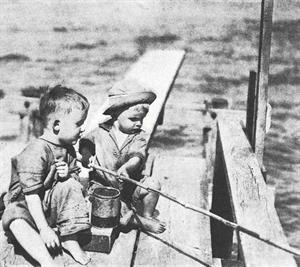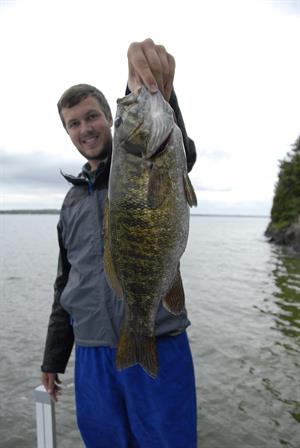By Scott Maxham, IWLA Clean Water Fellow

“Fishing gives the youngest boy his first contact with nature, his first feeling of mastery.” — Outdoor America magazine, 1926
I caught my first bass in Vermont. (That's not me in this photo. I'm in the one below.) My grandfather told me it was some time in the late 1990s. I didn’t tie the fly or bait the hook, but I was able to reel it in by myself. I find peace fishing the same waters as my forefathers.
The waters may not be as pristine as they once were, but the fish are always biting. Who do I have to thank for these bountiful fish populations? Well, in part I owe thanks to our founding Ikes. The early Ikes realized that overfishing was a big problem in the 1920s and speculated that bass would soon become extinct if common-sense fishing regulations were not put in place. These Ikes wanted to enjoy fishing and ensure that you and I today would have viable fish populations.

They first attempted to solve the problem with their nationally recognized “plant a bass” program. Then-Commerce Secretary Herbert Hoover commended the League, saying “The Bureau considers very favorably the ‘Plant a Bass’ campaign that is being conducted by the Izaak Walton League of America.” However, those stocking efforts were not enough to restore bass populations.
So early Ikes started a grassroots campaign urging Congress to pass the Black Bass Act of 1926. Countless editions of Outdoor America magazine contained calls to actions such as this: “Get every member in your chapter to not only write to Washington, but have them tell other people of your community to also write in.”
The problem was that large numbers of bass were being caught in public waters in certain states, smuggled in barrels lined with undesirable fish to another state, where the bass would be sold and consumed in restaurants. The Black Bass Act ended this practice by disallowing the commercial sale of bass in any state. Anyone caught transporting bass for commercial use could face a $500 fine (about $7,000 in today’s money) and up to six months in jail.
The Black Bass Act would go on to protect other at-risk fish species until it was combined with the Lacey Act in 1982.
Today, states face regionalized fish conservation issues that cannot be solved with a “one size fits all” piece of legislation. In California, salmon are losing habitat and have less to eat, and scientists worry the fish could become extinct in the next 50 years. The Great Lakes and Mississippi River face threats from invasive carp that feed on native fish. Anglers on the Gulf Coast may be taking more of their fair share of red snapper, and Gulf states continue to struggle to establish fair regulation that balances commercial and recreational needs.
There is hope in other parts of the country. The Chesapeake Bay is expected to produce record numbers of rockfish for the 2018 season. My beloved fishing hole of Lake Champlain has also received good news: lake trout have been able to naturally reproduce in the wild for the first time in over a century.
Fish require cool, clean water to thrive like they once did. Trout in small streams and rivers also require high amounts of dissolved oxygen. Oxygen can be stored in higher quantities in cooler water. This has many scientists worried that climate change may raise water temperatures and further reduce dissolved oxygen available to trout. It is up to us conservationists to advocate for solutions that will ensure the next generation of anglers has plenty of fish left to catch.